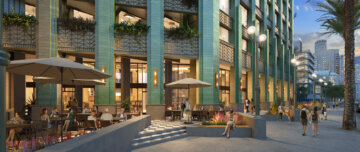 What a return-to-office means for office-to-residential
What a return-to-office means for office-to-residential
As more and more companies and institutions pull their staff back to the office, changes in the commercial office market will inevitably follow. But these office policy changes do not affect the nationwide housing shortage that continues to plague cities across the country.
Through the ups and downs of working in the office and working at home, demand remains continuous for amenity-rich, Class-A office spaces. Meanwhile, basic, dated office buildings have long struggled to fill vacancies. To reestablish value in the market, underperforming office buildings can be reimagined, whether as upgraded commercial offices, new residential or alternative uses. But what potential issues should we consider before taking that leap?
The Systems
Thorough analysis of existing building systems is needed to identify both required upgrades and opportunities for increased efficiency. For one such conceptual analysis, KTGY’s Research and Development Studio collaborated with structural engineer, John A. Martin & Associates, and construction firm, Swinerton, to conceptualize Upcycle Tower, a design concept for adaptive reuse of underutilized steel-framed office towers.
Addressing a common building type developed in Downtown Los Angeles during the 1980s and 1990s, but currently struggling with high vacancy, these 30-story to 40-story buildings often require structural intervention to meet current seismic requirements. Our Upcycle Tower study led to a solution that proposes a column-to-beam structural detail to reduce stress at the connection points in a relatively non-invasive manner.
The adaptive reuse process also offers an opportunity for upgrading mechanical systems and adding insulation to the exterior façade and windows. These system interventions can significantly increase the operational efficiency of the building.
The Floor Plates
Existing office buildings typically include deep floor plates and inoperable windows, undesirable features for residential buildings. Transforming the floor plates to accommodate residential units brings up challenges to provide the natural light to the most internal spaces.
Areas near the core of the building become wasted space, often limiting the overall building efficiency. Interlocking unit plans are a strategy for maximizing glazing exposure while maintaining widths desirable for residential spaces. By in-setting some sleeping spaces and using interior windows to provide natural light, these units can be both functional and efficient.
The Process
While most mixed-use high-rise buildings locate commercial office spaces at the lower floors of the building and residential units above, the Upcycle Tower concept proposes relocating existing office tenants to the upper floors of the building, allowing existing tenants to remain in place during construction.
The office tenants continue to use the existing chiller system on the roof of the building for HVAC, while the newly constructed residential units use a newly installed mechanical system, located at the ground level. This phased approach allows the building to remain partially functional throughout the conversion process.
The Unknowns
Beyond the asset acquisition cost, a base cost is required for interior tenant improvements and mechanical, electrical, and plumbing system upgrades necessary for reuse, even without a change in program. Additional known costs are then incurred for changes to programmatic elements, such as residential conversion and new amenity features. Further unknown costs become apparent later in the process, mitigated by conducting a comprehensive preliminary analysis.
Upcycle Tower also examines solutions for adding value through upgraded amenity features. With the transition from office to residential, the parking needs of the building are reduced, making the upper floor of the adjacent parking structure available for conversion to an upgraded residential amenity deck with fitness features and an outdoor pool.
The Economics
Office-to-residential conversion projects can face significant financial challenges, as office rents average higher than apartment rents, nationally, on a per-square-foot basis. Office leases typically run longer than residential rental agreements, adding stability within the market.
The per-square-foot cost for construction to convert office to residential is typically higher than ground-up residential construction, however, adaptive reuse solutions become an attractive option when timelines are reduced and tax incentives can bridge the financial gap. For example, California’s Assembly Bill 1490, approved in 2023, expedites a typically long review process by limiting office-to-residential projects with 150 units or fewer to no more than 60 days.
The Right Place at the Right Time, with the Right Support
The combination of high office vacancy and low residential inventory creates peak conditions for office-to-residential conversion. Atlanta, Denver, Phoenix, the San Francisco Bay Area, and Seattle have all been identified by a 2024 Urban Institute study as prime candidates to benefit most from office-to-residential conversion.
With consideration for absorption rates, office vacancy rates, and market rents, these municipalities could solve both their distressed office and housing supply challenges by encouraging this type of intervention.
Best use for future transformations largely depends on the specifics of the local market and political will. Cities experiencing particularly high commercial office vacancy rates might create policies to remove red tape for office-to-residential conversion projects. For example, New York, Dallas, and Washington, D.C., have all taken significant steps to encourage new office-to-residential development. Modified zoning laws allow residential development in commercial zones, removal of required traffic studies and public hearing streamlines the approval process, and tax incentives tip the scale on economic feasibility.
The Long-Term Benefits
In early zoning policies, cities (particularly in car-centric areas like Los Angeles) established a horizontal separation between commercial office buildings and residential development. These policies led to suburban sprawl and car dependence, while creating urban communities lacking vitality during evenings and weekends.
Prior to the post-pandemic shift toward remote work, municipalities had already recognized the potential benefit of integrating residential development into urban cores.
Diversity of functions grows the tax base while 24/7 visibility increases safety. After thoughtfully reimagining underutilized buildings within these cities, the next step will be further developing the support spaces necessary to sustain new residential components. Grocery stores, childcare facilities, and public parks form the third leg of the triangle, making city centers desirable communities positioned for long-term success.
Marissa Kasdan is the Director Research and Development for KTGY, where she leads the creation and execution of research and development projects, exploring new and emerging ideas related to building design and technology. She is the liaison for the studio, working with KTGY’s national executive leadership on new concepts and developing these concepts together with the R+D studio team.

